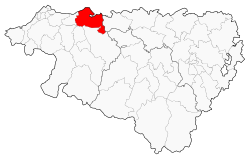Principality of Bidache | |||||||||
|---|---|---|---|---|---|---|---|---|---|
| 1570–1793 | |||||||||
 Bidache shown on a map of the modern départment of Pyrénées-Atlantiques | |||||||||
| Capital | Bidache | ||||||||
| Common languages | French Occitan and anciently Basque | ||||||||
| Religion | Roman Catholicism | ||||||||
| Government | Monarchy | ||||||||
| Prince | |||||||||
• 1570-1576 | Antoine I | ||||||||
• 1644-1678 | Antoine III, Marshal of France | ||||||||
• 1678-1695 | Antoine IV, Viceroy of Navarre | ||||||||
• 1745-1793 | Antoine VII | ||||||||
| Historical era | Renaissance | ||||||||
• Established | 21 October 1570 | ||||||||
• Independence declared by Antoine I, Prince of Bidache | 21 October 1570 | ||||||||
• Constitution | 6 April 1575 | ||||||||
• Territory is declared part of the French state by the King of France | 16 APril 1790 | ||||||||
• French Republican troops occupy Bidache and the prince is deposed | 1793 | ||||||||
• Integrated by France | 1793 | ||||||||
| |||||||||
| Today part of | |||||||||
The Principality of Bidache was from 1570 to 1793 a small feudal state in the south west modern-day France. The sovereignty of Bidache was proclaimed by the Antoine de Gramont in 1570. The Count of Gramont had formerly been a vassal of the King of Navarre but his family had last paid tribute to the king in 1434 and by now considered themselves relieved of their fealty.[1] The principality maintained dejure sovereignty until 1790 when by royal edict the territory of the principality was declared to be a part of France by Louis XVI. In 1793 the principality was occupied by troops loyal to the First French Republic and the last reigning prince, Antoine VII, was ousted. The royal and noble Gramont dynasty survive to the present day.

